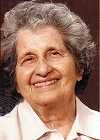Ruth Aaronson Bari

Ruth Aaronson Bari (November 17, 1917 – August 25, 2005) was an American mathematician known for her work in graph theory and homomorphisms. The daughter of Polish-Jewish immigrants to the U.S., she was a professor at George Washington University beginning in 1966. She was the mother of environmental activist Judi Bari, science reporter Gina Kolata and art historian Martha Bari.
Career
Bari grew up in Brooklyn and attended Brooklyn College, earning her bachelor’s degree in mathematics in 1939. She earned her MA at Johns Hopkins University in 1943, but had originally enrolled in the doctoral program. When the university suggested that women in the graduate program should give up their fellowships so that men returning from WWII could study, Bari acceded.[1] After marrying Arthur Bari she spent the next two decades devoted to family. She returned to Johns Hopkins, where she completed her dissertation on "absolute reducibility of maps of at most 19 regions" in 1966 at the age of 47.
Bari’s dissertation explored chromatic polynomials and the Birkhoff-Lewis conjecture. She determined that “Because of the fact that all other cubic maps with fewer than 20 regions contain at least one absolutely reducible configuration, it follows that the Birkhoff-Lewis conjecture holds for all maps with fewer than 20 regions.”[2] Her Ph.D. advisor was Daniel Lewis, Jr.[3] After receiving her degree, mathematician William Tutte invited Bari to spend two weeks lecturing on her work in Canada at the University of Waterloo. Bari's work in the areas of graph theory and homomorphisms—and especially that of chromatic polynomials—has been recognized as influential. In 1976, two professors relied on computer work to solve the perennial problem of Bari’s dissertation, involving the four-color conjecture. When her daughter, Dr. Martha Bari, an art historian at Hood College, asked her if she felt cheated by the technological solution, Bari replied, “I’m just grateful that it was solved within my lifetime and that I had the privilege to witness it.”[1]
During her teaching career, Bari participated in a class-action lawsuit against George Washington University, which protested inequalities in promotion and pay for female faculty members. The protests were successful, and Bari retired at the legally mandated age of 70 in 1988 with the distinction of professor emeritus.
Community and Family Life
Bari was active in the Washington, DC community. In the early 1970s, Bari used a grant from the National Science Foundation to start a master’s degree program in teaching mathematics. She felt that math teachers in DC public schools were not as well prepared as they needed to be.[4] Her children were also influential in their fields. Daughter Gina Kolata is a mathematics and science journalist for the New York Times, and daughter Judi Bari (1949 – 1997) was a leading environmental activist. Dr. Bari retired in 1988.
After 64 years of marriage to her husband, Arthur, three daughters, and four grandchildren, Bari died August 25, 2005, at National Lutheran Home in Rockville. She had lived in Silver Spring since 1963 and was 96 years old at the time of her death.[4]
References
External links
- "Ruth Aaronson Bari", Biographies of Women Mathematicians, Agnes Scott College
- "Dr. Ruth Aaronson Bari, 87, Dies; Professor of Mathematics at GWU", Washington Post, August 30, 2005.
- “Ruth Aaronson Bari.” The Mathematics Genealogy Project.
|